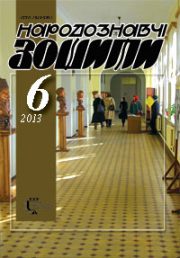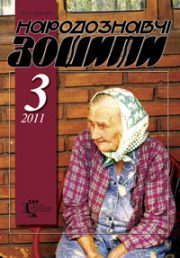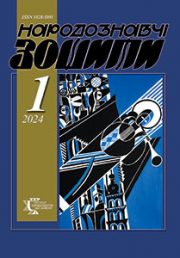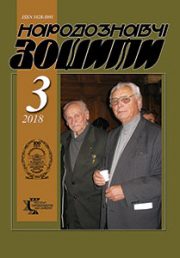The Ethnology Notebooks. 2019, № 5 (149), 1220—1227
UDK 398.7(476)
DOI https://doi.org/10.15407/nz2019.05.1220
SYSTEM OF VARIATION IN KUPALA SONGS
MAZURYNA Natallia
ORCID ID: https://orcid.org/0000-0001-5632-7844
candidate of Philology, associate Professor of literary studies
doctoral student of the Department of culture of Slavic peoples and folklore of the State scientific institution «Center for research of Belarusian culture,
language and literature of NAS of Belarus»
str. Surhanova, 1, Mins’k, 220072
e-mail: mazurynang@tut.by
Abstract. The article examines the system of variability on extensive factual material, Kupala songs year cycle of the Belarusian folklore. The purpose of the article is to identify the system of variation of Belarusian folk songs by using the method of system analysis in the framework of folkloristic research.
In the research process variability Kupala songs revealed a number of interrelated spheres of scientific research: continued record of Kupala songs and rituals in an authentic environment; defining the system model structures in Kupala folk songs; analysis of functional bases of Kupala songs and rituals; the disclosure of the ways and reasons of transformation of all components of the Kupala rituals and the related songs. The article analyzes the variability, which is a characteristic feature of almost all phenomena related to language and human creativity.
The typology of Kupala songs based on the essential features inherent in both verbal and musical text is briefly considered. It builds on the typology Kupala melodies by G V. Taulay. Each of the seven Belarusian Kupala song types are allocated according to functional-structural principle can be divided into intrapedigree types and mastimovie form. In the article, the characteristic of each type is limited to the description of only such features as melodic-textual (song) rhythm, the form of the text stanza, syllabic structure of the verse, the area of distribution. The article reveals and emphasizes the facts of existence of such or peculiar types of Kupala songs in Belarus and Ukraine.
The presented research is part of the author’s concept of variation of folk songs, built on the material, primarily Belarusian, as well as Ukrainian and Russian song folklore.
Keywords: variation, song folklore, Кupala songs, Кupalarites, tradition, changes.
Received 29.09.2019
REFERENCES
Fjadosik, A.S. (Ed.). (1985). Midsummer and Peter’s songs. Minsk: Navuka i tjehnika. (Belarusian folk art / AN BSSR, Institute of art history, еthnography and folklore) [in Belarusian].
Tavlaj, G.V. (1986). Belarusian Kupala: ritual, song. Minsk: Nauka i tehnika [in Russian].
Varfalameeva, T.B. (2001—2013). Traditional artistic culture of Belarusians : in 6 t. Minsk: Vyshjejshaja shkola [in Belarusian].
Bogdanovich, A.E. (1895). The remnants of the ancient world-view of Belarusians : an Ethnographic essay. M. [in Russian].
Hamenka, A. (2013). Socio-cultural changes of the celebration of Kupala and Rosalia. Authentic folklore: problems of preservation, study, perception: collection of scientific works of participants of the VII International scientific conference. Minsk [in Belarusian].
Kupala — 2012: where you can jump over the fire and look for «paparac’-Kvetka»? Retrieved from: http://www.interfax.by/article/93018 (Last accessed: 16.04.2013) [in Russian].
Kvitka, K.V. (1971). On the areas of distribution of some types of Belarusian calendar and wedding songs. Selected works (Vol. 1). M. [in Russian].
Zaval’njuk, A. F. (1983) Typology of Ukrainian summer ritual songs and their East Slavic substratum. Extended abstract of PhD dissertation. Kyiv [in Russian].
Folk songs in the writings of Hryhorij Ver’ovkа. (1971). Kyiv: Muz. Ukraina [in Ukrainian].
Dej, O.I., & Hrytsa S.J. (1971). Folk songs in Lesya Ukrainka’s recordings and from her singing. Kyiv: Muz. Ukraina [in Ukrainian].
Elatov, V.I. (1977). Songs of the East Slavic community. Minsk: Nauka i tehnika [in Russian].
Popova, T.V. (1983). Kupala songs in the Russian folk singing tradition. In Memory оf K.Kvitka. M. [in Russian].
Salavej, L.M. (Ed.). (1977). Ballads (Vol. 1). Minsk: Navuka i tjehnika. (Belarusian folk art / AN BSSR, Institute of art history, еthnography and folklore) [in Belarusian].







